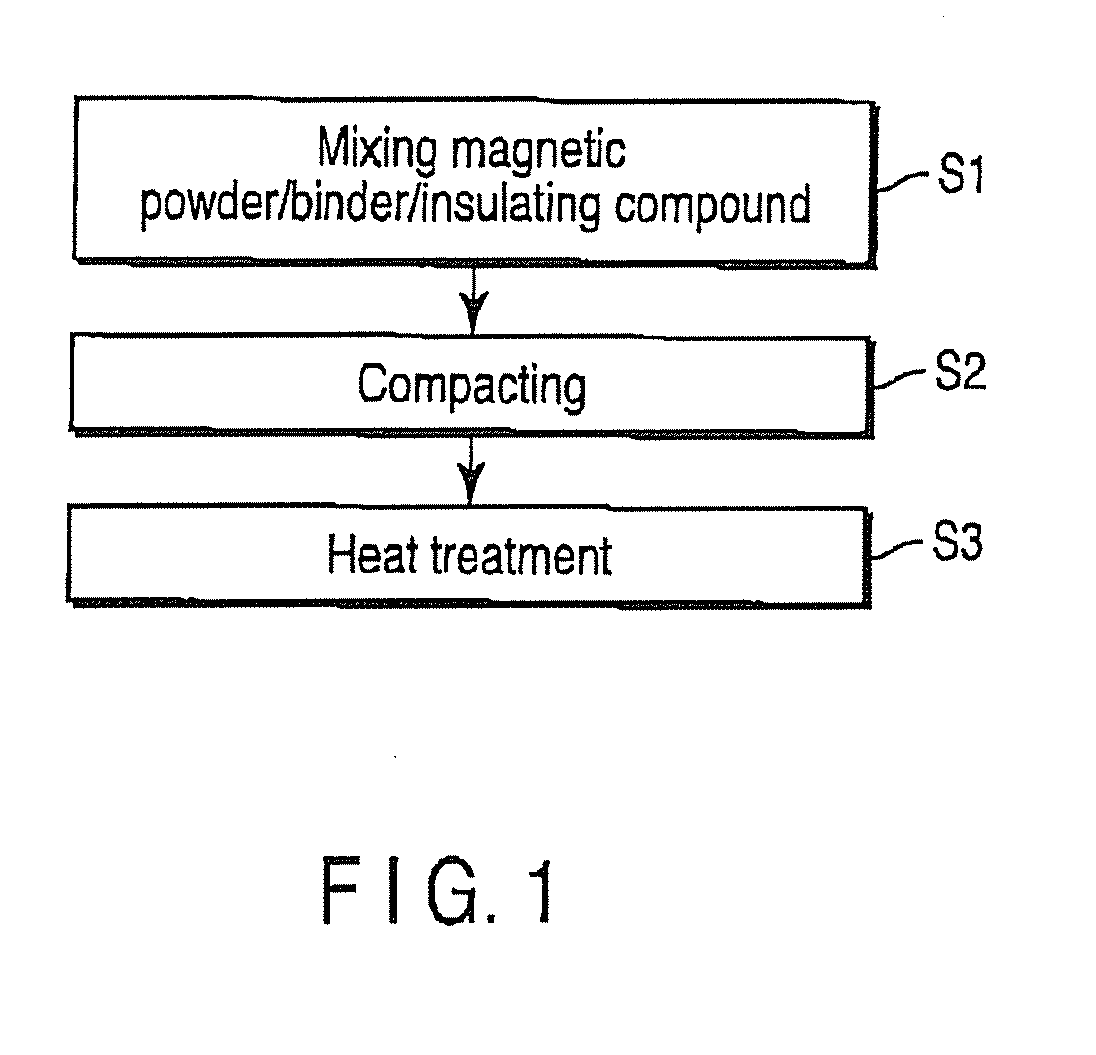Method of producing composite magnetic material and composite magnetic material
a technology of composite magnetic materials and magnetic materials, applied in the direction of magnetic bodies, inductances, transportation and packaging, etc., can solve the problems of low insulation property, low withstand voltage and achieve high withstand voltage, high insulation property, and impaired magnetic permeability or core loss
- Summary
- Abstract
- Description
- Claims
- Application Information
AI Technical Summary
Benefits of technology
Problems solved by technology
Method used
Image
Examples
example 1
[0049]So-called sendust alloy having composition of Fe,Si-9.5% by mass, and Al-5.5% by mass was prepared by vacuum dissolution method, and with a mechanical alloying, alloy powders having an average particle diameter of about 80 μm were obtained. A layered compound having an insulation property and a non-magnetic binder were added in an amount of 0.5% by mass and 1.0% by mass, respectively, compared to the alloy powders. By using methyl ethyl ketone, wet mixing was carried out, and then mixed powders were obtained by granulation under heating and drying. In this regard, the layered compound having an insulation property and the non-magnetic binder were talc and a silicone resin, respectively. By using the mixed powders obtained, compression compacting was carried with pressure of 1.8 GPa to produce a toroidal core having an outer diameter of 13.4 mm, an inner diameter of 7.7 mm and thickness of 5.5 mm. After that, the core was heat-treated in air at 750° C. for 1 hour to prepare the...
example 2
[0056]To the alloy powders having Fe,Si-9.5% by mass, and Al-5.5% by mass, which is the same composition as Example 1, an insulating layered compound and water glass as a binder were added, followed by wet-kneading with water. According to granulation under heating and drying, mixed powders were produced and the toroidal core which is identical to the Example 1 was produced. As an insulating layered compound, three kinds including bentonite, talc and mica were used. For each of these three kinds of an insulating layered compound, Sample Nos. 11 to 16 were produced (i.e., two for each compound), which are taken as Examples 2-1, 2-2, 2-3, 2-4, 2-5 and 2-6. Montmorillonite was included in the bentonite used. In addition, mica was finely pulverized using a pestle and mortar and then used. The toroidal core produced was subjected to the heat treatment by which it was maintained in air for 1 hour at temperature of 400° C. and 750° C., respectively. After that, the same test as Example 1 w...
reference examples 2 and 3
[0057]As Reference examples 2 and 3, samples of Sample Nos. 9 and 10 were prepared in which no insulating layered compound is added. After that, according to the same test as Example 1, evaluation was carried out. The results are shown in Table 2.
TABLE 2Temperaturefor heatElectricalWithstandSampleInsulatingtreatmentresistancevoltageMagneticCore lossNo.Divisionadditive(° C.)(Ω· m)(V)permeability(kW / m3) 9Reference—4004—463000example 210Reference—7507—601054example 311Example 2-1Bentonite4001.5 × 1044237408012Example 2-2Bentonite7502.3 × 10643.557135513Example 2-3Talc4001.0 × 10451.235395014Example 2-4Talc7501.8 × 10653.955115215Example 2-5Mica4002.9 × 1044536401016Example 2-6Mica7509.5 × 10545.8561221
[0058]As it is evident from Table 2, when only water glass was used, the electrical resistance was low and withstand voltage was not obtained. However, by adding an insulating layered compound, a desired insulation property and withstand voltage are attained, and as a result, it is excell...
PUM
| Property | Measurement | Unit |
|---|---|---|
| voltage | aaaaa | aaaaa |
| withstand voltage | aaaaa | aaaaa |
| temperature | aaaaa | aaaaa |
Abstract
Description
Claims
Application Information
 Login to View More
Login to View More - R&D
- Intellectual Property
- Life Sciences
- Materials
- Tech Scout
- Unparalleled Data Quality
- Higher Quality Content
- 60% Fewer Hallucinations
Browse by: Latest US Patents, China's latest patents, Technical Efficacy Thesaurus, Application Domain, Technology Topic, Popular Technical Reports.
© 2025 PatSnap. All rights reserved.Legal|Privacy policy|Modern Slavery Act Transparency Statement|Sitemap|About US| Contact US: help@patsnap.com



